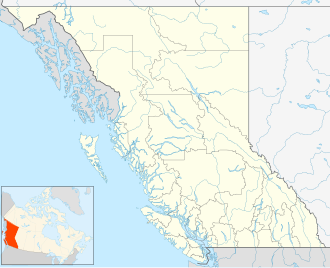| Pinecone-Burke Provincial Park | |
|---|---|
 An alpine meadow in Pinecone Burke Park | |
Location in British Columbia Location in Metro Vancouver | |
| Location | Metro Vancouver, British Columbia, Canada |
| Nearest city | Coquitlam |
| Coordinates | 49°31′44″N122°41′29″W / 49.52889°N 122.69139°W |
| Area | 380 km² |
| Established | 1995 |
| Governing body | BC Parks |
| Website | bcparks |
 | |
Pinecone Burke Provincial Park is a provincial park in British Columbia, Canada. It extends from the southwest corner of Garibaldi Provincial Park, west of Pitt Lake and Pitt River to include Burke Mountain in the City of Coquitlam. Most of the park is unserviced wilderness with very rough trails such as the Fools Gold Trail in the Boise Valley. There is canoe access to Widgeon Slough and from there hiking trails that lead to Widgeon Lake, and a network of old logging roads, hiking and mountain biking trails on Burke Mountain. [2] Visitors can also use the park for camping, backcountry skiing, and snowshoeing.
Contents
- History and past use of the area
- Geography
- Establishment of the protected area
- Park boundaries
- Management of the park
- Indigenous perspectives
- Current management
- Ecology
- Fauna
- Flora
- Visitors
- See also
- References
- External links
Before being protected, the park area was logged and mined. The park's boundaries were established in 1995 by the provincial government and covers 38,000 hectares. Parts of the park's boundaries are located in the Katzie First Nation, Kwikwetlem First Nation, and Stó:lō First Nation's territories. The park's diverse ecosystems supports several different species on land and in its inlet. There are six species that have been labeled as sensitive or vulnerable that live in the park.

